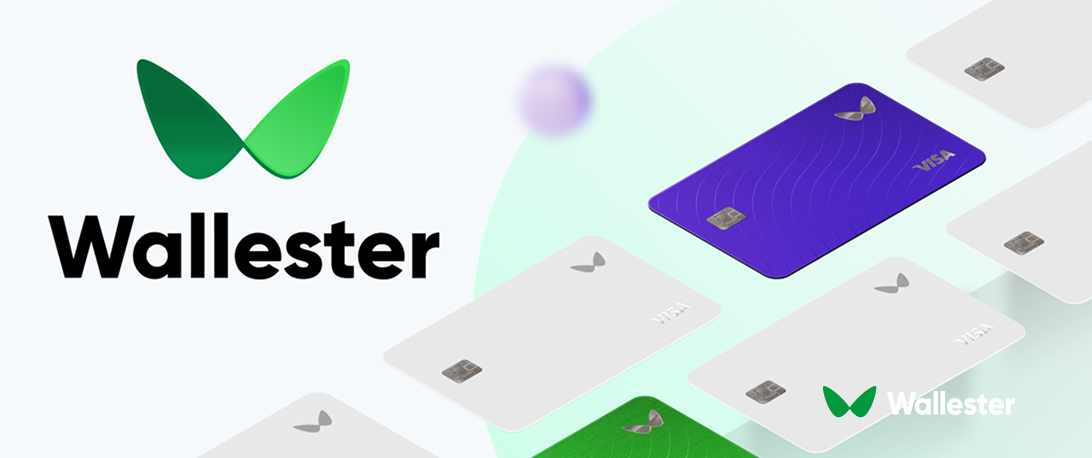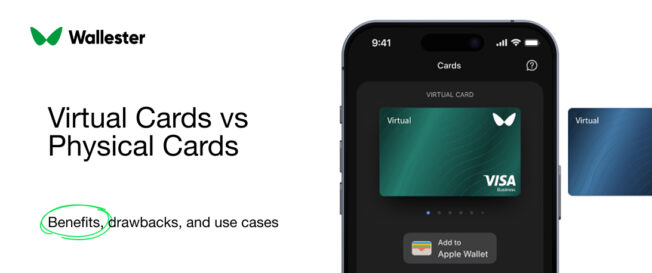Today’s consumers face more payment choices than ever before. As shopping habits shift between online and offline, the decision between virtual and physical cards becomes more important. Each has distinct advantages for different situations. This guide examines why you might choose one over the other and when each makes the most sense for your needs.
What is a virtual card?
A virtual card functions exactly like its plastic counterpart but exists only in digital format. It includes a unique 16-digit number, expiry date, and security code – everything needed for transactions without the physical object itself. These alternatives work primarily for online shopping where physical presentation isn’t required.
Virtual cards connect to your existing accounts. Many banks now offer both formats alongside traditional options. The main distinction is that virtual cards never materialize as objects – they remain entirely digital throughout their lifecycle.
How is a virtual card issued?
Getting a virtual card typically happens much faster than waiting for plastic in the mail. Most card issuers provide them through mobile apps or online banking portals, giving you almost immediate access after approval.
The process starts with an application through your bank or specialized provider. Once approved, your new details will be generated digitally and arrive via secure channels. Unlike traditional options that may take 7-10 days to arrive by mail, cards become available within minutes.
Many banks integrate virtual issuance directly into their mobile banking apps. Users simply request a new card and receive their details instantly. Some providers allow customers to create multiple cards for different purposes, each with unique numbers and customizable limits.
This quick issuance makes virtual payment instruments valuable for urgent purchases or when traveling abroad. If security issues arise, users can deactivate a compromised card and generate a new one much faster than replacing plastic ones.
Further Reading: How Virtual Cards Work: The Technology Behind the Solution
Benefits of virtual cards
Virtual cards solve numerous payment challenges beyond simple convenience. Consider these key advantages:
- Superior online security. They use unique numbers that limit exposure to specific merchants.
- Customizable spending controls.Set spending limits to prevent budget overruns.
- Simplified subscription management. Create dedicated cards for recurring payments.
- Instant availability. Access new cards immediately without waiting.
- Reduced fraud risk. Generate temporary ones for one-time purchases.
For businesses, virtual cards transform expense management by providing individual cards for each employee or department.
The temporary nature adds another layer of protection. Create cards that work only for specific time periods, spending amounts, or merchant categories – once those parameters expire, they become unusable, preventing unexpected charges.
The elimination of manufacturing also makes virtual cards more environmentally responsible than plastic ones. Without production materials or shipping requirements, they represent a more sustainable approach to modern digital transactions.
Drawbacks of virtual cards
Despite their advantages, virtual cards have limitations worth considering. The most significant restriction involves in-person transactions at physical stores. Since they exist only digitally, they won’t work at traditional point-of-sale terminals unless connected to a mobile wallet.
Cash withdrawals present another challenge for users. Most ATM machines require plastic for withdrawals. While some workarounds exist through digital wallet connections, this remains a notable limitation.
Some merchants still have trouble processing virtual cards, particularly for transactions requiring verification. Hotels, car rental agencies, and international vendors may request to see the actual plastic used for booking.
Technical requirements represent another consideration, as virtual cards need internet access and compatible devices. During network outages or in areas with limited connectivity, accessing your card details might become problematic.
When should I use a virtual card?
Virtual cards work best in specific situations where their unique features provide clear advantages. Consider using them for:
- Unfamiliar websites. When shopping from new or unknown online stores.
- Subscription services. Assign specific cards to different subscriptions.
- Free trials. Use limited options that prevent automatic billing afterward.
- Business expenses. Issue temporary ones to employees with preset boundaries.
- International online shopping. Minimise exposure with overseas merchants.
By assigning specific cards to each service type, you gain better visibility into monthly costs while maintaining the ability to cancel unwanted services easily.
For shared household expenses, virtual payment instruments offer excellent tracking capabilities. Family members can use designated cards for specific budget categories, making expense monitoring more transparent.
Further Reading: The Complete Guide to Virtual Cards for Business
The best ways to use virtual cards
To maximise the benefits of virtual cards, consider these strategic approaches. For recurring bills and subscription services, create dedicated cards for each category. This method allows precise tracking while establishing appropriate spending caps.
Online marketplaces and one-time purchases work perfectly with single-use virtual cards. Generate them with exact spending limits matching your purchase amount, then watch them deactivate automatically afterward.
Business expense management becomes more efficient with strategically deployed virtual solutions. Many companies now issue unique cards to different departments or for specific expense categories, streamlining accounting and providing real-time oversight.
Travel planning benefits from dedicated virtual cards for different aspects of your trip. Create specific cards for flight bookings, hotel reservations, and daily expenses to compartmentalise travel spending while adding security when using unfamiliar booking websites.

What is a physical card?
A physical card refers to the traditional plastic payment tool that has dominated wallets for generations. These items feature embossed or printed numbers, expiration dates, cardholder names, and security codes, supporting both in-person and online transactions. They have been standard payment methods for decades, working reliably across practically all merchant types.
They connect to either credit accounts or bank accounts, depending on function. The plastic construction usually includes security features like holograms, EMV chips for secure transactions, and sometimes magnetic stripes.
Unlike virtual alternatives, physical cards provide tangible credentials that merchants can examine during in-store purchases when verification becomes necessary. They work across all environments including restaurants, retail stores, and service providers without requiring additional technology.
Many modern cards now include contactless payment capabilities, allowing tap-to-pay functionality at compatible terminals. This feature bridges some convenience gaps while maintaining versatility.
How is a physical card issued?
The issuance process follows a more traditional timeline than virtual cards. After applying through a bank or financial institution, approval triggers production at a secure facility. This manufacturing process creates the plastic with appropriate security elements, encodes your account information, and prepares it for delivery.
Once produced, plastic cards travel via postal mail to your verified address, typically taking 7-10 business days in most locations. For security purposes, many financial institutions send the item and PIN separately or require activation before first use.
The physical delivery requirement serves as a security feature, helping ensure they reach intended recipients at confirmed addresses. Upon arrival, holders typically sign the back and follow activation instructions before beginning to use them. Replacements follow this same process when items become lost, stolen, or expired. While expedited shipping sometimes helps speed delivery, the fundamental requirement for production creates a time gap between approval and availability.
Benefits of physical cards
Traditional plastic cards maintain several distinct advantages:
- Universal acceptance. Nearly all merchants worldwide accept them.
- Reliable in-person transactions. Work seamlessly at restaurants and shops.
- Cash access. Enable ATM withdrawals worldwide.
- No technical dependencies. Function without internet.
For situations requiring verification, physical credit cards satisfy merchant requirements without complications. Hotels, car rental agencies, and certain service providers often request to see the actual plastic used for booking as a security measure.
Many modern cards offer additional features embedded in the plastic itself, such as contactless payment capabilities, loyalty program identification, and even biometric authentication in premium versions.
Further Reading: Is Cards-as-a-Service a Better Fit for You Than Banking-as-a-Service?
Drawbacks of physical cards
Despite their widespread acceptance, plastic cards have limitations. Security vulnerabilities top the list of concerns – they can be lost or stolen, potentially enabling unauthorised spending before the owner notices and reports the problem.
They face greater exposure to skimming devices and visual compromise. Criminals can capture details through modified payment terminals or simply by observing payment information during transactions.
Replacement logistics create frustrations when items go missing, suffer damage, or expire. Owners typically wait 7-10 business days for replacements to arrive, causing significant inconvenience. This delay contrasts sharply with the immediate availability of virtual cards.
The environmental impact presents another downside, as production involves plastic materials, manufacturing processes, and shipping logistics that create resource waste. With millions produced yearly worldwide, this environmental cost continues growing despite sustainability efforts.
When should I use a physical card?
Traditional plastic cards remain optimal in several common scenarios:
- In-store shopping. Works reliably at retail locations.
- International travel. Provides universal payment capabilities.
- ATM withdrawals. Offers straightforward cash access worldwide.
- Car rentals and hotels. Satisfies requirements for presentation.
- Restaurants and services. Functions efficiently where servers process credit card payments.
Emergency situations also warrant carrying plastic as a backup. During power outages, device failures, or connectivity problems, physical cards continue working normally while virtual cards might become temporarily inaccessible.
Certain merchant categories still process plastic more efficiently than digital alternatives. Gas stations, parking facilities, transit systems, and older payment infrastructures often work more reliably with physical cards.
The best ways to use physical cards
To maximise the benefits of physical credit cards, consider these strategic approaches. For travel purposes, use plastic with no foreign transaction fees to save money on international purchases. Many premium travel cards include built-in benefits like travel insurance and airport lounge access.
Security-conscious consumers often implement a two-card strategy – carrying a primary plastic card for everyday purchases while keeping a backup secured separately. This approach maintains continuous access even if a wallet gets lost or stolen.
For building credit history, physical cards often report more comprehensively to credit bureaus than virtual. Using them responsibly for regular expenses helps establish strong credit profiles that benefit future financing opportunities.
Businesses frequently provide plastic to employees who travel regularly or make frequent in-person purchases. They simplify expense reporting while providing necessary payment capabilities across all merchant environments.
Key differences between physical and virtual cards: an overview
When comparing traditional plastic and virtual cards, several fundamental differences shape their respective strengths and limitations:
| Feature | Physical | Virtual |
| Transaction compatibility | Works online and in-person | Primarily online unless linked to mobile wallets |
| Security approach | Tangible item with standard protections | Limited-use numbers with customisable parameters |
| Issuance timeline | 7-10 business days | Nearly immediate availability |
| Cash access | Works at ATMs worldwide | Limited or no direct ATM access |
| Merchant acceptance | Nearly universal | Some limitations with certain merchants |
| Spending controls | Account-level limits | Specific customisable limits |
Security approaches differ significantly between formats. Virtual cards minimise exposure through limited-use numbers and preset spending parameters. Traditional plastic offers universal utility but creates greater risk through potential loss or theft.
Issuance timelines create another clear distinction. Virtual cards become available almost immediately after approval, while physical ones require production and shipping processes spanning 7-10 business days typically.
Spending control mechanisms show interesting variations between formats. Virtual credit cards excel at granular control through single-merchant limitations, exact spending caps, and time-limited validity. Traditional plastic typically offers broader account-level controls rather than specific parameters.
Virtual or physical cards: which is better?
Determining which card better suits your needs depends on your specific usage patterns and priorities. Neither qualifies as universally “better” – each excels in different situations based on unique characteristics.
For security-focused individuals who primarily shop online, virtual credit cards offer compelling advantages through limited exposure and detailed control options. The ability to generate unique numbers for different merchants minimises vulnerability while simplifying subscription management.
Those who travel frequently or regularly make in-person purchases often find traditional plastic more practical. The universal acceptance across global merchants, restaurants, and service providers ensures payment capabilities regardless of location or technical infrastructure.
Many people find the optimal solution involves strategically combining both types:
- Using traditional plastic for in-person shopping and cash access
- Employing digital alternatives for online payments and subscriptions
- Maintaining at least one backup traditional card for emergencies
- Creating temporary virtual cards for unfamiliar websites
Virtual cards vs. physical cards: case studies
Real-world examples show how different users apply both formats to address specific needs. Young professionals often prefer virtual credit cards for daily transactions, particularly for managing subscription services, where they appreciate the easier tracking and straightforward cancellation processes.
In business expense management, companies increasingly introduce virtual cards to separate spending by department or platform. For example, a marketing agency might assign a different virtual card to each advertising channel, improving transaction visibility and making expense reconciliation simpler. At the same time, physical cards are often retained for situations like business travel or client meetings where a tangible payment method is still convenient.
Family budgeting also highlights the value of a hybrid approach. Some households choose to allocate virtual credit cards for specific categories such as groceries, entertainment, or fuel, helping them maintain greater control over monthly budgets. Physical cards, meanwhile, continue to serve as a backup for emergencies or broader expenses.
The combined use of virtual and physical cards increasingly defines modern financial management strategies. Instead of asking which format is better overall, users tend to select the tool that best fits each specific payment scenario.
Further Reading: Virtual Cards vs. Physical Cards: What’s Better for Business?
How do I get a virtual card in the UK?
Obtaining a virtual card in the UK has become straightforward. Most major UK banks now offer them as part of standard account packages or premium services. Customers can request them through mobile banking apps or online portals.
Several fintech companies provide alternative access routes in the UK market:
- Wallester: Offers instant issuance of an unlimited number of virtual cards with advanced expense tracking and control features
- Revolut: Offers virtual solutions with customisable controls
- Monzo: Provides options with detailed spending analytics
- Starling Bank: Features seamless mobile wallet integration
- Wise (formerly TransferWise): Includes multi-currency cards
The application process involves simple verification steps for existing customers. New customers may need to complete standard verification measures. Once approved, details become available immediately through secure channels.
Features vary across different UK providers. Some focus primarily on security aspects like single-use numbers and merchant restrictions, while others emphasise expense tracking and business integration capabilities.
For business users, several providers offer dedicated solutions with team management features, approval workflows, and comprehensive reporting tools. These business-oriented options provide administrator dashboards for overseeing multiple accounts across departments.
Further Reading: The Best Corporate Cards in the UK for 2025
Why choose Wallester’s virtual cards?
Wallester Business offers a practical way to issue and manage virtual corporate cards, balancing security, flexibility, and ease of use.
Companies can create an unlimited number of virtual cards with individual spending limits, merchant category restrictions, and set validity periods. Cards are available instantly and can be added to mobile wallets like Apple Pay and Google Pay.
Enhanced security is a strong focus. Wallester applies 3D Secure authentication, monitors transactions in real time, and allows immediate freezing or cancellation of any card. All systems meet PCI DSS and PSD2 requirements, helping protect company funds at every stage.

The platform connects easily with accounting software, ERP systems, CRM tools, and internal platforms through an API-based structure. This connection supports more accurate expense tracking without extra manual work.
Wallester virtual cards are accepted worldwide, supporting payments in multiple currencies with clear fee structures and competitive exchange rates. Whether teams are local or remote, businesses can manage international spending with full control.
Through a central dashboard, companies can view all transactions, adjust spending rules when needed, generate reports, and manage cards quickly. Support teams are available to assist with any financial or technical questions, helping businesses stay focused on their core operations.


